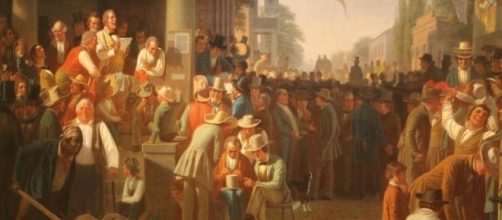You probably don’t think of the GOP as an art lover. After all, Republicans in the House of Representatives are known for wanting to slash federal spending when it comes to the National Endowment for the Arts. Yet, Trump’s inaugural luncheon has set a place at the table for a painting called “Verdict of the People” by 19th century artist George Caleb Bingham, which the event invitation rightly describes as a “chaotic street scene just as a clerk calls out the electoral results.” The uproar comes from a tense mix of both overjoyed and dejected people after the election of 1850 when only white men were permitted to cast a ballot.
The unhappy people in the picture are black slaves and women. U.S. Sen. Roy Blunt, who chairs the inaugural festivities, chose the image, likely to make the point that the Electoral College rules the day, that Trump’s win is part of that history, and never mind that he lost the popular vote by some 3 million.
Putting one’s cards on the table
Bingham’s painting is on loan from the St. Louis Art Museum and art historian Ivy Cooper of Southern Illinois University Edwardsville and Ilene Berman, a St. Louis artist, object to using the picture at the inaugural lunch. Calling it stagecraft, they see Blount’s action as an attempt to normalize Trump’s presidency by casting his victory as part of an American tradition.
Cooper told the press that using Bingham’s picture at the inaugural may also have the effect of endorsing Trump’s expressed values of hatred, misogyny, racism and xenophobia. Mostly, though, the petition rejects use of “Verdict of the People” because it suggest that Trump’s election constituted such a verdict, when in fact the majority of votes were cast for his opponent.” So far, their petition bears 1,950 signatures and counting.
Doesn’t anyone pay attention to what paintings are about anymore?
While this column agrees that bringing Bingham’s painting to the inaugural lunch is a bad idea, it’s not for the reasons given by Berman and Cooper. Has anyone really looked at this picture? It’s a veritable illustration of their protest because their petitioners are represented in the painting acting out their pique that the electoral vote didn’t speak for them, that a minority of voters - 538 electors to be exact - decided the election.
“Art of the Deal”: Talk about cons
One more thing: Using a painting to honor Trump prompts memory of something he wrote in his book “The Art of the Deal”: “I’ve always felt that a lot of modern art is a con, and that the most successful painters are often better salesmen and promoters than they are artists.” In case you’re thinking that modernism didn’t start until the 20th century, you’re forgetting 19th century painters like Francisco Goya, Eugene Delacroix and Edouard Manet.

